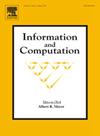Concept analysis approach for graphs
IF 1
4区 计算机科学
Q3 COMPUTER SCIENCE, THEORY & METHODS
引用次数: 0
Abstract
Graphs possess the ability to model complex systems in the real world, leading to their widespread application in fields such as social network analysis and recommendation systems. However, one of the major challenges in processing graph data lies in the inherent structural complexity of graphs. Consequently, extracting meaningful structural information from graph data has become a significant area of research. Formal Concept Analysis provides a method for expressing and analyzing algebraic structures by constructing concept lattices, which can effectively uncover complex structures within data. This paper proposes a concept analysis approach for graph data, revealing the relationship between graph structures and their corresponding concepts. Initially, the paper focuses on the connected components of disconnected graphs, exploring their specific representations in their respective concept lattices, and demonstrating that each connected component corresponds to a connected equivalence class within its associated lattice. Subsequently, the paper investigates the correspondence between graph structures of connected components and their associated concepts, identifying the concepts corresponding to cliques and to non-clique connected subgraphs. The findings indicate that these graph structures can be reconstructed through their corresponding concepts, thereby transforming operations on graph structures into operations on concepts and offering a novel perspective on graph structure manipulation. Finally, the paper analyzes the correspondence between concepts in concept lattices and graph structures, revealing the rationale behind concept construction. The results show that the concepts are closely related to a special class of graph structures, namely maximal star-clique graphs.
图的概念分析方法
图具有在现实世界中对复杂系统进行建模的能力,这使得它们在社会网络分析和推荐系统等领域得到了广泛的应用。然而,处理图数据的主要挑战之一在于图固有的结构复杂性。因此,从图数据中提取有意义的结构信息已成为一个重要的研究领域。形式概念分析提供了一种通过构造概念格来表达和分析代数结构的方法,可以有效地揭示数据内部的复杂结构。本文提出了一种图数据的概念分析方法,揭示了图结构与其对应的概念之间的关系。首先,本文将重点放在断开图的连通分量上,探索它们在各自概念格中的具体表示,并证明每个连通分量对应于其关联格中的一个连通等价类。随后,研究了连通分量的图结构与其关联概念之间的对应关系,确定了团和非团连通子图对应的概念。研究结果表明,这些图结构可以通过其对应的概念进行重构,从而将对图结构的操作转化为对概念的操作,为图结构的操作提供了一种新的视角。最后,分析了概念格中概念与图结构之间的对应关系,揭示了概念构建的基本原理。结果表明,这些概念与一类特殊的图结构密切相关,即极大星团图。
本文章由计算机程序翻译,如有差异,请以英文原文为准。
求助全文
约1分钟内获得全文
求助全文
来源期刊

Information and Computation
工程技术-计算机:理论方法
CiteScore
2.30
自引率
0.00%
发文量
119
审稿时长
140 days
期刊介绍:
Information and Computation welcomes original papers in all areas of theoretical computer science and computational applications of information theory. Survey articles of exceptional quality will also be considered. Particularly welcome are papers contributing new results in active theoretical areas such as
-Biological computation and computational biology-
Computational complexity-
Computer theorem-proving-
Concurrency and distributed process theory-
Cryptographic theory-
Data base theory-
Decision problems in logic-
Design and analysis of algorithms-
Discrete optimization and mathematical programming-
Inductive inference and learning theory-
Logic & constraint programming-
Program verification & model checking-
Probabilistic & Quantum computation-
Semantics of programming languages-
Symbolic computation, lambda calculus, and rewriting systems-
Types and typechecking
 求助内容:
求助内容: 应助结果提醒方式:
应助结果提醒方式:


